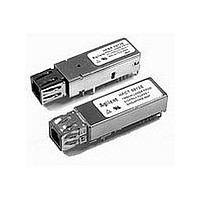HFBR-0562 Avago Technologies US Inc., HFBR-0562 Datasheet - Page 5

HFBR-0562
Manufacturer Part Number
HFBR-0562
Description
Fiber Optics, Evaluation Kit
Manufacturer
Avago Technologies US Inc.
Specifications of HFBR-0562
Silicon Manufacturer
Avago
Silicon Core Number
HFBR-591xE, HFCT-591xE
Kit Application Type
Communication & Networking
Application Sub Type
MT-RJ Gigabit Ethernet Transceiver
Main Purpose
Interface, Ethernet
Embedded
No
Utilized Ic / Part
HFCT-591xE, HFBR-591xE
Primary Attributes
MT-RJ 1.25Gb Multimode Applications
Secondary Attributes
MT-RJ Fiber Connector Interface
Description/function
Fiber Optic Kit
Lead Free Status / RoHS Status
Lead free / RoHS Compliant
For Use With/related Products
HFBR-591x
Lead Free Status / RoHS Status
Lead free / RoHS Compliant, Contains lead / RoHS non-compliant
Eye Safety Circuit
For an optical transmitter device
to be eye-safe in the event of a
single fault failure, the transmit-
ter must either maintain eye-safe
operation or be disabled.
In the HFBR-5912E there are
three key elements to the laser
driver safety circuitry: a monitor
diode, a window detector circuit,
and direct control of the laser
bias. The window detection
circuit monitors the average
optical power using the monitor
diode. If a fault occurs such that
the transmitter dc regulation
circuit cannot maintain the
preset bias conditions for the
laser emitter within ± 20%, the
transmitter will automatically be
disabled. Once this has occurred,
an electrical power reset or
toggling the transmit disable will
allow an attempted turn-on of the
transmitter. If fault remains the
transmitter will stay disabled.
The HFCT-5912E utilizes an
optical subassembly consisting of
a short piece of single mode fiber
along with a current limiting
circuit to guarantee eye-safety. It
is intrinsically eye safe and does
not require shut down circuitry.
Signal Detect
The Signal Detect circuit provides
a TTL low output signal when the
optical link is broken or when the
transmitter is OFF as defined by
the Gigabit Ethernet specification
IEEE 802.3z, Table 38.1. The
Signal Detect threshold is set to
transition from a high to low
state between the minimum
receiver input optional power and
-30 dBm avg. input optical power
indicating a definite optical fault
(e.g. unplugged connector for the
receiver or transmitter, broken
fiber, or failed far-end transmitter
or data source). A Signal Detect
indicating a working link is
functional when receiving
encoded 8B/10B characters. The
Signal Detect does not detect
receiver data error or error-rate.
Data errors can be determined by
signal processing offered by
upstream PHY ICs.
Electromagnetic
Interference (EMI)
One of a circuit board designer’s
foremost concerns is the control
of electromagnetic emissions
from electronic equipment.
Success in controlling generated
Electromagnetic Interference
(EMI) enables the designer to
pass a governmental agency’s
EMI regulatory standard and
more importantly, it reduces the
possibility of interference to
neighboring equipment. Agilent
has designed the HFBR/HFCT-
5912E to provide excellent EMI
performance. The EMI
performance of a chassis is
dependent on physical design and
features which help improve EMI
suppression. Agilent encourages
using standard RF suppression
practices and avoiding poorly
EMI-sealed enclosures.
Radiated Emissions for the
HFBR-5912E and HFCT-5912E
have been tested successfully in
several environments. While this
number is important for system
designers in terms of emissions
levels inside a system, Agilent
recognizes that the performance
of most interest to our customers
is the emissions levels, which
could be expected to radiate to
the outside world from inside a
typical system. In their
application, SFF transceivers are
intended for use inside an
enclosed system, protruding
through the specified panel
opening at the specified
protrusion depth.
5
Along with the system advantage
of high port density comes the
increase in the number of
apertures. Careful attention must
be paid to the locations of high-
speed clocks or gigabit circuitry
with respect to these apertures.
While experimental measurements
and experiences do not indicate
any specific transceiver emissions
issues, Agilent recognizes that
the transceiver aperture is often a
weak link in system enclosure
integrity and has designed the
modules to minimize emissions
and if necessary, contain the
internal system emissions by
shielding the aperture.
To that end, Agilent’s gigabit
MT-RJ transceivers (HFCT-5912E
and HFBR-5912E) have nose
shields which provide a
convenient chassis connection to
the nose of the transceiver. This
nose shield improves system EMI
performance by closing off the
MT-RJ aperture. Localized
shielding is also improved by
tying the four metal housing
package grounding tabs to signal
ground on the PCB. Though not
obvious by inspection, the nose
shield and metal housing are
electrically separated for
customers who do not wish to
directly tie chassis and signal
grounds together. The
recommended transceiver
position, PCB layout and panel
opening for both HFBR-5912E
and HFCT-5912E are the same,
making them mechanically drop-
in compatible. Figure 6 shows
the recommended positioning of
the transceivers with respect to
the PCB and faceplate.
























